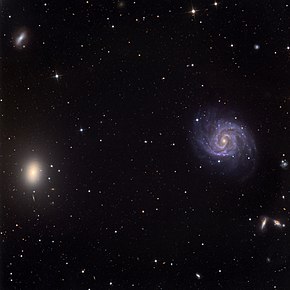Features
NGC 1052 is located at a distance of around 63 million light years from the Milky Way, [4] and has a LINER-type active galactic nucleus which signals the intense starburst activity in the galaxy's center [5] that were confirmed with observations with better resolution showing a number of star-forming regions and young star clusters. [6]
NGC 1052 shows also two small jets emerging from its nucleus as well as a very extended disc of neutral hydrogen, far larger than the galaxy itself. [7] Additionally, the stars and the ionized gas rotate along different axes. [8] All these features suggesting a gas-rich galaxy collided and merged with it 1 billion years ago producing all the above features. [6]
The shape of NGC 1052 is thought to be a triaxial ellipsoid. The longest axis of the ellipsoid is probably aligned at a position angle of −41°, which is the axis around which the ionized gas would be rotating. [8]
A scale image of NGC 1052 and its satellite galaxies is available at the reference. [9]
Central black hole
NGC 1052 hosts a rapidly rotating supermassive black hole with a mass of 154 million M☉ [10] with a large magnetic field of 2.6 Tesla, [11] which, according to astronomer Anne-Kathrin Baczko, the leader of the team that made this discovery, provides enough magnetic energy to power the previously mentioned twin relativistic jets. [12]
This black hole is a promising target for imaging by the Event Horizon Telescope. [11] The location of the black hole in NGC 1052 was by 2016 the most precisely known in the universe, with the exception of Sagittarius A*, the supermassive black hole found at the heart of our own galaxy. [12] [11]
This page is based on this
Wikipedia article Text is available under the
CC BY-SA 4.0 license; additional terms may apply.
Images, videos and audio are available under their respective licenses.
